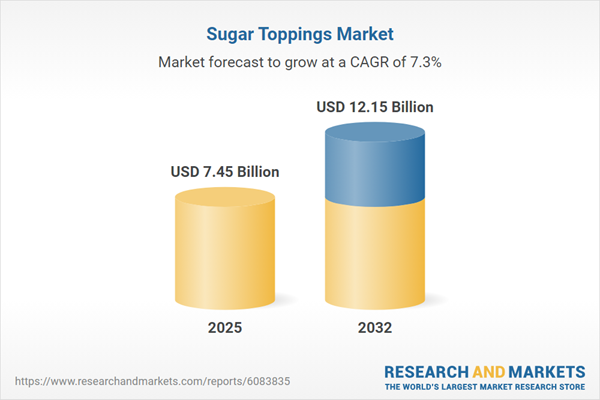Speak directly to the analyst to clarify any post sales queries you may have.
The sugar toppings market is navigating a period of significant transformation, as evolving consumer tastes, innovation in food ingredients, and changes to global trade policy reshape competitive strategies across the supply chain. For senior leaders, aligning product, sourcing, and market expansion initiatives within this dynamic context is essential to capture value.
Market Snapshot: Sugar Toppings Market Growth and Outlook
The sugar toppings market grew from USD 6.94 billion in 2024 to USD 7.45 billion in 2025. It is expected to continue growing at a CAGR of 7.25%, reaching USD 12.15 billion by 2032. This robust trajectory highlights strong demand for indulgent, customizable toppings among commercial bakers, confectioners, beverage brands, and food retailers worldwide. The market is benefitting from the convergence of premiumization trends, new flavor development, and the push for operational efficiency in both retail and foodservice sectors.
Scope & Segmentation: Defining Opportunities in the Sugar Toppings Market
- Product Types: Brown (dark, light), Flavored (caramel, chocolate, fruit, vanilla), Granulated, Powdered.
- Applications: Bakery (bread, cakes, pastries), Beverages, Cereals and Snack Bars, Confectionery, Dairy.
- Distribution Channels: Convenience Stores, Food Service, Online Retail (branded websites, e-commerce marketplaces), Specialty Stores, Supermarkets and Hypermarkets.
- Packaging Types: Bulk (loose bags, T bags), Jars, Packets, Sachets.
- Price Tiers: Economy, Premium, Standard.
- Certifications: Fair Trade, Kosher, Non-GMO, Organic.
- Geographies: Americas (United States, Canada, Mexico, Brazil, Argentina, Chile, Colombia, Peru), Europe, Middle East & Africa (UK, Germany, France, Eastern Europe, UAE, Saudi Arabia, South Africa, Nigeria, Egypt, Kenya), Asia-Pacific (China, India, Japan, Australia, Indonesia, Thailand, Malaysia, Singapore, Taiwan).
Key Takeaways: Critical Insights for Senior Decision-Makers
- Consumer demand is driving greater diversity in flavor profiles and functional ingredients, expanding the use of sugar toppings far beyond traditional formats.
- Strategic investments in clean label formulations, plant-based alternatives, and specialty blends align with both health and sustainability trends.
- Digital transformation across sourcing and distribution channels—specifically, e-commerce and analytics—facilitates market reach and data-driven product innovation.
- Sophisticated partnership models between producers and foodservice chains accelerate go-to-market cycles and foster innovation through collaboration.
- Manufacturers leveraging novel production methods, such as advanced coating and encapsulation, achieve improved shelf life, product stability, and market differentiation.
- Supply chain agility and local sourcing are becoming competitive advantages in response to trade shifts and changing input costs worldwide.
Tariff Impact: Navigating Trade Policy Adjustments
The introduction of new U.S. tariffs in 2025 has prompted market participants to re-evaluate sourcing strategies and supplier relationships. With upward pressure on the cost of imported sugar derivatives, companies are exploring alternative suppliers and investing in domestic production capacity to mitigate risks. Bilateral negotiations, long-term contracting, and the development of premium, differentiated offerings are key responses to this evolving environment.
Methodology & Data Sources
This report employs a rigorous mix of primary and secondary research, including interviews with stakeholders throughout the value chain and comprehensive review of industry publications. Data triangulation strengthens reliability, while quantitative methods and scenario planning inform market projections and trend analyses.
Why This Report Matters: Actionable Benefits for Leadership Teams
- Enables incisive decision-making with validated insights into product innovation, trade dynamics, and market opportunities.
- Equips organizations to proactively adapt to regulatory changes, consumer shifts, and technological advances shaping the industry.
Conclusion
With ongoing shifts in consumer behavior, technology, and policy, the sugar toppings market offers compelling opportunities for forward-thinking leaders. Strategic alignment and agility will define success as companies position themselves for sustainable growth and differentiation.
Table of Contents
3. Executive Summary
4. Market Overview
7. Cumulative Impact of Artificial Intelligence 2025
Companies Mentioned
The companies profiled in this Sugar Toppings market report include:- The J. M. Smucker Company
- Dr. Oetker GmbH
- Wilton Brands LLC
- General Mills, Inc.
- The Hershey Company
- B&G Foods, Inc.
- McCormick & Company, Inc.
- Nestlé S.A.
- Puratos NV
- Cargill, Incorporated
Table Information
| Report Attribute | Details |
|---|---|
| No. of Pages | 184 |
| Published | October 2025 |
| Forecast Period | 2025 - 2032 |
| Estimated Market Value ( USD | $ 7.45 Billion |
| Forecasted Market Value ( USD | $ 12.15 Billion |
| Compound Annual Growth Rate | 7.2% |
| Regions Covered | Global |
| No. of Companies Mentioned | 11 |









